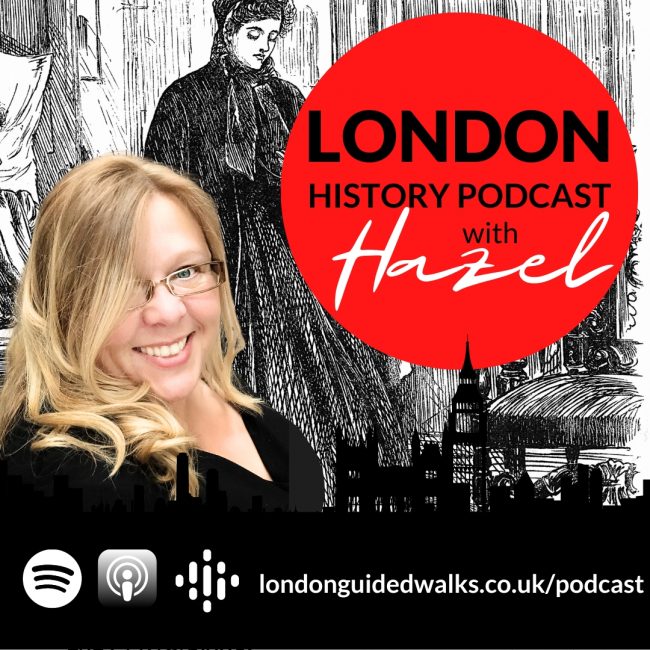London’s Pillar Boxes
Visit The Postal Museum:
Show Notes:
 Hazel Baker: Hello and welcome to London Guided Walks London History podcast. In the coming episodes, we will be sharing our love and passion for London, its people, places and history in an espresso shot with a splash of personality. For those of you who don’t know me, I am Hazel Baker, founder of London Guided Walks, providing guided walks and private tours to Londoners and visitors alike.
Hazel Baker: Hello and welcome to London Guided Walks London History podcast. In the coming episodes, we will be sharing our love and passion for London, its people, places and history in an espresso shot with a splash of personality. For those of you who don’t know me, I am Hazel Baker, founder of London Guided Walks, providing guided walks and private tours to Londoners and visitors alike.
London’s Pillar Boxes
Joanna Espin, Curator of the Postal Museum is going to be giving us a run down of three pillar boxes you can get out and see in London and take you on a whistle stop tour of London’s post box history.
Pillar boxes are a symbol of Britain, a national design icon. Something we pass by on the street everyday but they have a long and interesting history which we can journey through today….
Why were pillar boxes introduced?
The introduction of pillar boxes is linked to the 1840 penny post revolution in communications which saw the cost of posting a letter reduced to 1p and ultimately saw many, many more letters being posted. Up to this point you could either take your mail to a letter receiving house, which could be miles away, or handed to a bell man, who was literally a man with a bell and a bag who would ring his bell and collect letters. When the scale of posting letters increased dramatically, new infrastructure was needed to deal with this and Anthony Trollope, best known as a Victorian novelist but who was also employed by the Post Office for over 30 years, had seen pillar boxes in use while travelling on the continent. Trollope suggested a trial of pillar boxes in this country.
When was the first pillar box trial? Was it in London?
The first pillar box trial ran outside of London, in Jersey in 1853, as I said, at the suggestion of novelist Anthony Trollope. At this point the pillar boxes were red, so the colour we largely associate today with pillar boxes.
The second trial was also in the Channel Islands, this time on Guernsey. One of these boxes from the trial is still in use on the island today, and we have the other survivor in the collection at The Postal Museum – one of only two surviving, oldest pillar boxes in the country is in the collection at The Postal Museum in London
And which pillar boxes would you recommend people get out and see in London?
So the first pillar box I would recommend people get out and see is also the newest on my list of 3 London pillar boxes… but it’s masquerading as something much older.
It’s on St Martin’s Le Grand, so not far from St Paul’s Cathedral and it is a replica of a Victorian Penfold post box, named after its designer, J W Penfold, an architect. The box was first erected in 1866. It’s a hexagonal shape, and has a number of decorative balls going round the top of the box. So one way, if you want to impress your friends with some insider post box identification skills, to tell the size of the penfold is to count its balls. 9 balls along the front of the box means it’s a small penfold, 10 balls means it’s large.
The replica penfold was put here in 2016 to mark the 500th anniversary of the founding of the post office – which has it’s routes back in the early 16th century when Henry VIII appointed the first postmaster, Brian Tuke. The replica penfold on St Martin’s le Grand was unveiled by Prince Charles. It’s located in an important place in London’s postal past as St Martin’s le Grand was the site of the GPO headquarters from 1829 until the building was demolished in 1912.
If you do visit the replica penfold on St, Martins le grand, make sure you walk through Postman’s Park to visit the Rowland Hill statue on King Edward Street. Rowland Hill was the driving force behind the penny post revolution and his statue is outside King Edward building, which was once the main sorting office for London and overseas mail, together with the capital’s main public post office, after it opened in 1910.
This part of London was once filled with GPO buildings and Generations of Londoners and thousands of Post Office workers came to know the area as the hub of the capital’s postal and telegraphic services. In its heyday it was, so to speak, London’s ‘Post Office Quarter’.
When did London get its first pillar box?
The second pillar box I recommend you get out and see is as much to soak up the history of the area as to see the box itself and it commemorates the first pillar boxes in London, which were introduced in 1855 on five London streets: Fleet Street, Strand, Piccadilly, Pall Mall and Rutland Gate. I’d suggest you go and see the pillar box on Fleet Street which isn’t one of the original London boxes but it was given a special plaque commemorating the 1855 introduction of pillar boxes (along with the boxes on the other four ‘original’ streets), and the plaque was installed on the bicentenary of Anthony Trollope. When you look at the box in Fleet Street, you’ll see Queen Victoria’s cypher, the letters VR in cursive lettering. And looking out for the cypher is the easiest way to date a pillar box as the cypher of the ruling monarch at the time of the box’s production is depicted on each pillar box.
All these boxes are quite big, were there any small post boxes in Victorian London?
Yes, so towards the end of the 19th century the demand for more convenient posting facilities for London squares increased (and it’s around these squares that some of London’s more influential residents lived), so small boxes were designed. The boxes were made to attach to existing lamp posts, they are known as lamp boxes, and were big enough to hold small letters. After being introduced in London in 1897, they began to appear in small numbers across the country and were later removed from London squares. So this isn’t a type of box you’ll see on your walks around London.
And what’s the third pillar box you recommend people go to see in London?
Lastly, I would recommend people go to Westminster and see the gold painted pillar box there which commemorates London as the host city of the 2012 Olympic and Paralympic Games. As you probably know a pillar box was painted gold for each gold medallist from Team GB when London was the host city of the Games back in 2012. Pillar boxes have been quite a few colours over the years: starting off as red, then being painted green. After suggestions the green boxes were difficult to find (especially in rural areas) the boxes returned to red. Air mail boxes in the 1930s were a dreamy shade of blue. Gold boxes appeared as I mentioned after the 2012 Olympics and most recently, this year, several post boxes have been painted blue as a thank you to the NHS during the pandemic, one of which you can see outside St Thomas’ Hospital in London – where the Prime Minister was treated for coronavirus. So the story of pillar boxes in London is still evolving today.
The Postal Museum has now re-opened to the public. You can discover more about the history of the post by visiting this fabulous central London museum.

 Hazel Baker:
Hazel Baker: 









